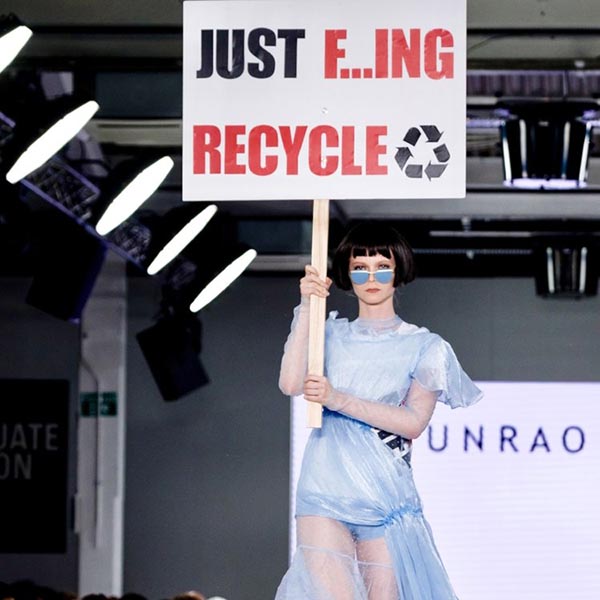Digital Printing Unlocks the Sustainable Supply Chain
Now is the time to make textile printing sustainable.


Caption: Digital Print is now a viable alternative, available to all textile manufacturing businesses and print buyers. It offers incredible versatility and, most importantly, addresses the commercial needs of a marketplace that has changed beyond all recognition over the last 15 years. (Source: Debbie McKeegan/Texintel.com)
Digital textile printing has now been around for more than two decades and is seen by all as the future of print. Early machines were slow and unstable, offering a solution for product sampling and little more. It has taken years of research and development to establish digital textile printing as a viable alternative to conventional screen printing for fashion and home furnishings. The development was held back for years by printhead and ink technologies, which were slow to catch up with the commercial digital print reform that we witnessed in the 1990s for digital paper printing.
It offers incredible versatility and, importantly, addresses the commercial needs of a marketplace that has changed beyond all recognition over the past 15 years. Digital print does, meter for meter, still cost more than conventional rotary print and yet, as a sector, it’s set for massive growth, predicted at 18% in the next three years globally. We have to ask ourselves, “Why?” There are a number of fundamental drivers that are fueling the growth in digital print technology. For manufacturing, the most important are sustainability, speed, flexibility and new emerging markets.
Undoubtedly, the biggest change lies within consumer behavior and the global push-back against two decades of fast fashion and a worldwide resistance to mass production. As a new generation of environmentally conscious consumers wields its buying power, the textile marketplace has had to adapt to restructure and consolidate the manufacturing supply chain and continues to do so. Software has facilitated this reform, and automation has a huge role to play.
The Eco-Conscious Consumer
Sustainability is driving the agenda, and rightly so. Not so long ago, just being organic was considered “good enough," but today’s consumer has an eco-conscience, and the market must supply the products that they want to purchase.
The fashion industry is the second-biggest consumer of water, producing 20% of wastewater, while also generating more greenhouse gas emissions and using more energy than all international flights and maritime shipping combined. Traditional processes of dyeing and printing textiles put huge strains upon local ecosystems worldwide and the raw material resources of the countries in which they operate.

Caption: Sustainability is driving the agenda, and rightly so. Not so long ago, just being organic was considered “good enough,” but today’s consumer has an eco-conscience, and the market must supply the products that they want to purchase.(Source: Debbie McKeegan/Texintel.com)
It is well-known that digital textile printing has an extraordinarily low consumption of electricity—it is typically 3.5% of screen printing’s energy requirement. However, it is in its water usage where the difference is really felt. Taking printed cotton as an example, conventional reactive printing uses between 50 and 60 liters of water per meter produced in order to generate the color depth and fastness required. This water is then discharged as effluent into the local water system where the chemicals and dyes used pollute the local environment, unless they are re-processed through expensive effluent treatment plants.
By contrast, digitally printed cotton virtually eliminates the consumption of water and the discharge of noxious effluents.
Using low volumes of liquid dispersion of pigment colors, digital print achieves similar physical results to traditional technologies without the huge environmental impact of rotary or flatbed printing. This is because the ink used in digital textile printing is typically 10% of the volume used in screen printing.
Pigment-based digital printing also removes the need for post-processing water and energy usage, since colorfastness is achieved by heat fixation alone as opposed to lengthy steam fixation and washing off procedures.
The Mass Market
Digital textile printing not only offers the fashion industry an elegant and cost-effective production system, it also offers an opportunity for the industry to dramatically reduce waste and energy consumption as well as improve our chemical and environmental sustainability.
But as the market gears up toward the eventual digital switchover, there are issues with the sustainable supply chain regarding the raw components. Stella McCartney, a lifetime advocate for sustainable manufacturing, recently commented at the Copenhagen Fashion Summit on the poor availability of sustainable fabrics and components for those manufacturers that want to be greener. There are huge gaps in the supply of core products with a green eco passport. And, what’s more, they are often an expensive option.
Until the large brands that consume vast volumes of cotton and polyester switch to a policy of sustainable supply (and many have pledged to), this will remain the case. Currently, digital print is measured at between 5–7% of the global textile print marketplace; we are only at the beginning of this journey.
At present, sustainable products are not available to the mass market at an affordable price and remain a “luxury” purchase with a premium price tag. The lack of readily available, affordable consumables also applies to the digital print industry. Many ink suppliers offer, or are hurrying to develop, eco-friendly inks. But what exactly does “eco-friendly” mean? It’s not good enough to loosely use a word to reassure the consumer as to the precise composition of the raw components in the prints that they procure. Consumers want detailed information as to the chemicals that contact their skin. To meet the growing needs of our future consumers and the preservation of our planet, the print marketplace desperately needs standardization and clear certification.
It’s equally difficult to ascertain the chemical composition of printed cotton and polyester base fabrics as a printer (analog or digital). In order to digitally print cotton, for example, the fabric also has to be pre-treated with a chemical mix to fix the printed color to the surface of the cloth, but the base cloth may already contain numerous nasty chemicals added during regular textile processing. Buying consumables from a certified source is critical. The certification of the final product will vary depending on the ink, coating composition and coating method, in addition to the base fabric source.
Only when the entire supply chain is certified can we pass on a truly sustainable product.
A Clear Future
The end user demands clarity, and it will soon be a requirement for all print manufacturers, large and small, to list the certifications that apply to their products. Currently, these critical details are neither regulated nor compulsory for the sale of many products, and the boundaries remain blurred for required end use.
However, there is light at the end of this complex tunnel; and various essential certifications for sustainability and ethical supply are now in the public domain—GOTS, Sedex, REACH, UL208, Bluesign and Oeko-Tex, to name a few—some of which have existed for many years within our industry and are becoming an increasingly popular—and important—requirement. Certification is now an essential marketing tool for manufacturers and retailers alike, but in the past would seldom have been used as it is today as marketing collateral. Many printers and print buyers now require certification to offer clients a responsible product with a sustainable integrity.
Sustainable supply and certification is a vast and complex issue. For many digital manufacturers new to the textile marketplace, it’s an essential learning curve that cannot be overlooked. Professional advice is essential.
In the fast-paced world of print-on-demand and just-in-time manufacturing, new skills are now required for efficient manufacturing. Digital printing technology has without a doubt, simplified the print process and now offers a viable, sustainable alternative to conventional print. We have removed forever many of the inefficient layers of the traditional process for manufacturing textiles; and my wish is that we now strive to remove the toxic chemicals currently used in textile fabric processing. Digital print technology is a versatile, fast, efficient and sustainable way of going about it, and it is definitely the future.
Collectively, we are now entering a new era of textile technology. And the truth is that in order to improve global sustainability, we must now develop new technologies that efficiently address recycling, circular design and sustainable processing, manufacturing and supply.
Creating sustainable products isn’t necessarily a green process. Recycling demands energy and water and creates waste. How we address and measure these issues will determine the future.
Consumers are willing to pay more for sustainability; how much more has yet to be determined. As the millennial generation comes of age, buying sustainable products is becoming a primary reason for purchase. Today’s consumers and industry professionals demand sustainable products. As an industry, it’s our job to meet those demands and deliver against them.

